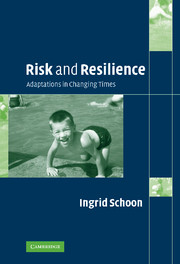Book contents
- Frontmatter
- Contents
- List of figures
- List of tables
- Foreword by Glen H. Elder, Jr
- Preface by John Bynner
- Acknowledgements
- Introduction
- 1 Risk and resilience: definitions
- 2 Towards a developmental-contextual systems model of adjustment
- 3 Persisting inequalities in times of social change
- 4 Selection, causation and cumulative risk effects
- 5 Protective factors and processes
- 6 Stability of early adjustment over time
- 7 Personal goals and life plans
- 8 Conclusions and outlook
- 9 Implications of findings for interventions and social policy
- Appendix A Two British birth cohorts
- Appendix B Response rates and handling of missing data
- Appendix C Description of variables used in the study
- References
- Index
1 - Risk and resilience: definitions
Published online by Cambridge University Press: 22 September 2009
- Frontmatter
- Contents
- List of figures
- List of tables
- Foreword by Glen H. Elder, Jr
- Preface by John Bynner
- Acknowledgements
- Introduction
- 1 Risk and resilience: definitions
- 2 Towards a developmental-contextual systems model of adjustment
- 3 Persisting inequalities in times of social change
- 4 Selection, causation and cumulative risk effects
- 5 Protective factors and processes
- 6 Stability of early adjustment over time
- 7 Personal goals and life plans
- 8 Conclusions and outlook
- 9 Implications of findings for interventions and social policy
- Appendix A Two British birth cohorts
- Appendix B Response rates and handling of missing data
- Appendix C Description of variables used in the study
- References
- Index
Summary
What we really want to understand are the processes of human development in different times and places, for individuals with varying risks and assets, and for individuals developing in a variety of social contexts.
(Rigsby, 1994, p. 91)Why study the occurrence of resilience, and how to conceptualise and measure the phenomenon? In this chapter, issues concerning the definition and operationalisation of resilience will be reviewed and discussed. The concept of resilience is examined, laying out underlying assumptions about the processes and conditions that are assumed to give rise to the manifestation of resilience. Concerns regarding the value of the concept, the way it is measured, and how it had been used in the explanation of behaviours and outcomes will be addressed.
Why does the study of resilience matter?
A growing concern in social policy over the last decade has been the increasing marginalisation of less privileged individuals and relatively disadvantaged social groups. The foundations of ‘social exclusion’ processes are laid down early in life through exposure to socio-economic risk factors identified with adverse circumstances at home and at school (Atkinson & Hills, 1998; Bynner, 2001a; Duncan & Brooks-Gunn, 1997; Luthar, 1999; McLoyd, 1998). Children reared in disadvantaged or deprived circumstances are at increased risk of adverse developmental outcomes ranging from educational underachievement and behavioural problems to adjustment problems in later life, such as low occupational status and poor health (Duncan & Brooks-Gunn, 1997; Essen & Wedge, 1978; Rutter & Madge, 1976).
- Type
- Chapter
- Information
- Risk and ResilienceAdaptations in Changing Times, pp. 5 - 17Publisher: Cambridge University PressPrint publication year: 2006



